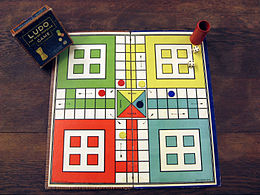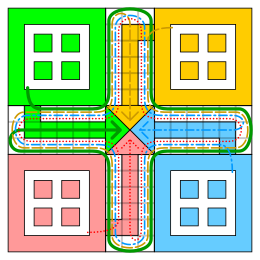Rules of Ludo
Ludo (/ˈljuːdoʊ/; from Latin ludo '[I] play') is a strategy board game for two to four players, in which the players race their four tokens from start to finish according to the rolls of a single die.
Ludo board

Special areas of the Ludo board are typically coloured bright yellow, green, red, and blue. Each player is assigned a colour and has four tokens in their colour. The board is normally square with a cross-shaped playspace, with each arm of the cross having three columns of squares, usually six per column. The middle columns usually have five squares coloured; these represent a player's home column. A sixth coloured square not on the home column is a player's starting square. At the centre of the board is a large finishing square, often composed of coloured triangles atop the players' home columns (thus depicting "arrows" pointing to the finish).
Rules
Overview

Two, three, or four can play, without partnerships. At the beginning of the game, each player's four tokens are out of play and staged in the player's yard (one of the large corner areas of the board in the player's colour). When able to, the players enter their tokens one per turn on their respective starting squares and proceed to race them clockwise around the board along the game track (the path of squares not part of any player's home column). When reaching the square below their home column, a player continues by moving tokens up the column to the finishing square. The rolls of a single die control the swiftness of the tokens, and entry to the finishing square requires a precise roll from the player. The first to bring all their tokens to the finish wins the game. The others often continue to play to determine second-, third-, and fourth-place finishers.
Gameplay
Each player rolls a die; the highest roller begins the game. Players alternate turns in a clockwise direction. To enter a token into play from its yard to its starting square, a player must roll a six. Players can draw a token from home every time they get a six unless home is empty or move a piece six times. The start box has two own tokens (is doubled). If the player has no tokens yet in play and rolls other than a six, the turn passes to the next player.
Players must always move a token according to the die value rolled. Once players have one or more tokens in play, they select a token and move it forwards along the track the number of squares indicated by the die. If a token advances onto a spot occupied by opponent's token then the opposing token is returned back to its respective home point. This forces the opponent to roll another 6 to take it out of their home and move it again. If a token advances onto a spot occupied by a token of the same colour, then they create something that is called a "block". If an opposing token lands on the same spot as the block, the advancing token is returned back to its respective home point.
If the player cannot draw a token from home, rolling a six earns the player an additional or "bonus" roll in that turn. If the bonus roll results in a six again, the player earns again an additional bonus roll. If the third roll is also a six, the player may not move and the turn immediately passes to the next player.
A player's home column squares are always safe, since no opponent may enter them. In the home column, a player cannot jump over; after one rotation is completed, the player must enter the home and roll the exact number needed to get each token onto the home triangle..
By: https://en.wikipedia.org/wiki/Ludo
